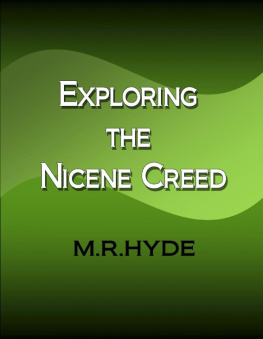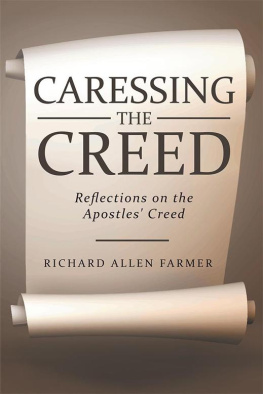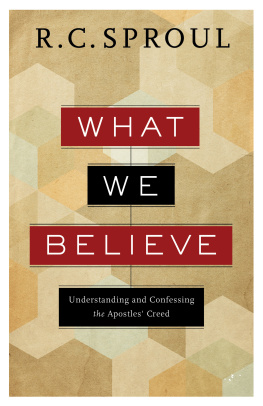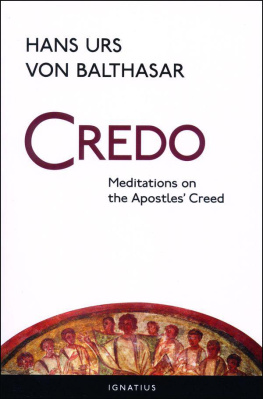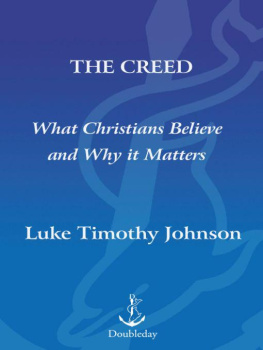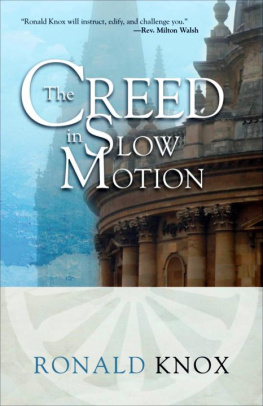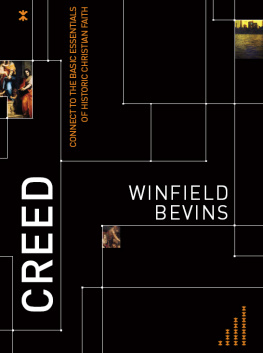The Creed Explained
By Silvia Vecchini
Illustrated by Antonio Vincenti
To speak about faith is to talk about God
In these pages, you will come to know the Apostles Creed more deeply. We call it a creed because it begins with the word credo, which is Latin for I believe. The creed is a summary of the true faith that all Christians believe.
This ancient text is still recited by the Church today. When we profess the Creed, we retrace the Bibles message and Jesus life. We say publicly that we are placing our trust in God, and we proclaim our faith in the Church. In the Creed, we speak about our biggest hopes and what our faith teaches about who God is for us.
Symbol
For many centuries, the creed has also been known as the symbol of faith. But what exactly does this phrase mean? Lets first take a look at the word symbol.
Symbol comes from the Greek word symbolon and means a gathering or collection or a summary. It can also mean half of a broken object. In ancient times, a symbol was used as a token of identity when agreements or alliances were made. Two individuals, families, or even cities would break a tessera, a clay seal usually made of terra cotta, into two pieces. Each side would save one of the two parts. The perfect fit of the broken pieces proved the existence of the agreement. The symbol was a unique sign that identified who had made an agreement or pact. In describing the Creed, Saint Augustine wrote, It is called the Symbol because with it Christians recognize one another.
Even today, reciting the Creed is how we bring together the token of identity in Christ that each one of us carries. As we stand to profess our faith, the Creed enables us to present ourselves to God together, in communion with one another. The Creed unites and creates communion: whoever recites the Creed is identified as part of a believing community.
I and we!
The Creed is a confession of faith made by each person (I believe). But at the same time it is a confession that happens from within a community. (We see this in the words our Lord, Catholic Church, and communion of saints). The faith is expressed by each one of us, because each individual makes a choice , a deeply personal choice, to believe the truths we profess.
Still, this profession is larger than any individual believer because the Creed proclaims the faith that the whole Church has kept and passed on to us.
Personal faith and the faith of the whole Church are bound together. They cannot be divided. Everyone who says I believe becomes part of the one community of faith in Jesus Christ. Although the Church is more than just a group of individuals, the faith of each member is what unites them.
A legend... and its truth
The Apostles most likely did not actually write the Creed. However, they did teach what is contained in the Creed. In the earliest years of the Church, a written Creed did not yet exist. Faith was handed on in much the same way family traditions are. Some of those traditions are legends.
According to one legend, the Apostles wrote this brief creed as a model for their preaching when they prepared to carry the Gospel to the world. The story even specifies that each of the twelve Apostles proposed one of the twelve articles, or parts, of the Creed!
Even if this legend is not historically accurate, we can say that it is based on an important truth: the Creed, the Symbol of The Apostles, echoes the faith of Jesus first Apostles in a way that reaches us.
Lets see why.
The origin of the Creed is ancient. This text contains the truths of faith by which the first Christians recognized one another. It was closely tied to Baptism. Those who wanted to be baptized and become Christians, called catechumens (ca-tuh-KEU-mens), had to prepare themselves well. During Lent, they had an extended period of formation in which the leaders of the Christian community explained what they believed.
As the day of Baptism approached, the catechumens recited the Creed before the community and the bishop as a sign of their faith. They became full members of the Christian community when they were baptized, usually on Easter.
Different historical periods and various churches have had their own versions (or formulas) of the Creed. These formulas differ in some ways, but they all reflect what is written in the New Testament and they all witness to the life of the first Christian communities.
In the first few centuries after Jesus resurrection, the Churchs reflection on the Christian life and message matured. Our faith was able to be synthesized or summed up into the twelve articles that have been handed down to us.
Are we ready to get to know the articles of the Creed one by one?
In the fourth century, Saint Cyril of Jerusalem wanted to explain to people the importance of the Creed. Before doing so, he turned to his listeners and said:
Be careful to guard and keep the teachings that you are now receiving, and write them in the depths of your heart.
We begin our discovery of the Creed, one article at a time, so that the Creed can be imprinted in our hearts! Words from the Fathers of the Church and some Christian authors will help us to explore and better understand our faith.
As we go ahead you will also find Notebook pages: these are spaces for your thoughts and questions. There are reflections on these pages that can help you consider what you have read.
1st Article
I believe in God, the Father almighty, Creator of heaven and earth
I believe in you, God, but my belief is just a small seed. Help my faith grow. Nourish me with your love, and let my faith deepen, mature, and always be in bloom.
I believe in God
Why does the Creed begin like this? Is it really that important to believe in God? Yes it is, because having faith changes our lives! Those who believe in God
recognize Gods greatness and goodness
live with a heart full of gratitude
know that all people are brothers and sisters
use their gifts in an appropriate way
have faith in Gods love, even in moments of difficulty
I believe in God...
God revealed his name to Moses when he encountered the burning bush, saying, I am who am (Ex 3:14). What does this name mean? That God is present in our life, attentive to our prayer, and ready to save us.
One God in the Holy Trinity




